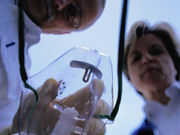Guidance relates to care team, resources committed to patient care, pediatric-specific techniques
MONDAY, Nov. 30, 2015 (HealthDay News) — Guidance is offered for the pediatric perioperative anesthesia environment in a policy statement published online Nov. 30 in Pediatrics.
Noting that infants younger than 1 year and children with complex comorbidities have a higher risk of perioperative morbidity and mortality, David M. Polaner, M.D., from the Children’s Hospital Colorado in Aurora, and colleagues developed recommendations relating to the perioperative care of pediatric patients receiving anesthesia.
The authors provide recommendations relating to issues for the perioperative anesthesia environments, which includes the training and experience of the health care team; the resources committed to medical and psychosocial care of infants and children in the perioperative period; and pediatric-specific techniques for airway management, administration of fluid, temperature regulation, insertion of catheters, cardiorespiratory monitoring, and pain management. Facilities caring for children should have written policies relating to pediatric operative, diagnostic, and therapeutic procedures requiring anesthesia; these policies should be based on the capability of the patient care facility and its medical staff. Patient care facilities should also have policies for effective pediatric pain management.
“Essential components are identified to optimize the perioperative environment for the anesthetic care of infants and children,” the authors write. “Such an environment promotes the safety and well-being of infants and children by reducing the risk of adverse events.”
Copyright © 2015 HealthDay. All rights reserved.








